2008 年 12 月英语六级真题及答案
Part I Writing (30 minutes)
Directions: For this part, you are allowed 30 minutes to write a short essay entitled How to
improvepsychologicalhealth?Youshouldwriteatleast150wordsfollowingtheoutlinegiven
below.
1. 学生心理健康的重要性
2. 学校应该怎样做
3. 学生自己应该怎样做
How to improve psychological health
Part II Reading Comprehension (Skimming and Scanning) (15 minutes)
Directions: In this part, you will have 15 minutes to go over the passage quickly and answer
thequestionsonAnswerSheet1.Forquestions1-7,choosethebestanswerfromthefourchoices
markedA),B),C)andD).Forquestions8-10,completethesentenceswiththeinformationgiven
in the passage.
Supersize SurpriseAsk anyone why there is an obesity epidemic and they will tell you that it's
all down to eating too much and burning too few calories. That explanation appeals to common
sense and has dominated efforts to get to the root of the obesity epidemic and reverse it. Yet
obesity researchers are increasingly dissatisfied with it. Many now believe that something else
must have changed in our environment to precipitate(促成) such dramatic rises in obesity over
the past 40 years or so. Nobody is saying that the “big two” – reduced physical activity
and increased availability of food – are not important contributors to the epidemic, but they
cannot explain it all.
Earlier this year a review paper by 20 obesity experts set out the 7 most plausible alternative
explanations for the epidemic. Here they are.
1. Not enough sleep
It is widely believed that sleep is for the brain, not the body. Could a shortage of shut-eye
also be helping to make us fat?
Several large-scale studies suggest there may be a link. People who sleep less than 7 hours
a night tend to have a higher body mass index than people who sleep more, according to data
gathered by the US National Health and Nutrition Examination Survey. Similarly, the US Nurses'
Health Study, which tracked 68,000 women for 16 years, found that those who slept an average
of 5 hours a night gained more weight during the study period than women who slept 6 hours,
who in turn gained more than those who slept 7.
It's well known that obesity impairs sleep, so perhaps people get fat first and sleep less
afterwards. But the nurses' study suggests that it can work in the other direction too: sleep
loss may precipitate weight gain.
Although getting figures is difficult, it appears that we really are sleeping less. In 1960
people in the US slept an average of 8.5 hours per night. A 2002 poll by the National Sleep
Foundation suggests that the average has fallen to under 7 hours, and the decline is mirrored
by the increase in obesity.
2. Climate control
We humans, like all warm-blooded animals, can keep our core body temperatures pretty much
constant regardless of what's going on in the world around us. We do this by altering our
�
metabolic (新陈代新的) rate, shivering or sweating. Keeping warm and staying cool take energy
unless we are in the “thermo-neutral zone”, which is increasingly where we choose to live
and work.
There is no denying that ambienttemperatures(环境温度) have changed in the past few decades.
Between 1970 and 2000, the average British home warmed from a chilly 13℃ to 18℃. In the US,
the changes have been at the other end of the thermometer as the proportion of homes with air
conditionings rose from 23% to 47% between 1978 and 1997. In the southern states – where obesity
rates tend to be highest – the number of houses with air conditioning has shot up to 71% from
37% in 1978.
Could air conditioning in summer and heating in winter really make a difference to our weight?
Sadly, there is some evidence that it does – at least with regard to heating. Studies show
that in comfortable temperatures we use less energy.
3. Less smoking
Bad news: smokers really do tend to be thinner than the rest of us, and quitting really does
pack on the pounds, though no one is sure why. It probably has something to do with the fact
that nicotine is an appetite suppressant and appears to up your metabolic rate.
Katherine Flegal and colleagues at the US National Center for Health Statistics in Hyattsville,
Maryland, have calculated that people kicking the habit have been responsible for a small but
significant portion of the US epidemic of fatness. From data collected around 1991 by the US
National Health and Nutrition Examination Survey, they worked out that people who had quit in
the previous decade were much more likely to be overweight than smokers and people who had never
smoked. Among men, for example, nearly half of quitters were overweight compared with 37% of
non-smokers and only 28% of smokers.
4. Genetic effects
Your chances of becoming fat may be set, at least in part, before you were even born. Children
of obese mothers are much more likely to become obese themselves later in life. Offspring of
mice fed a high-fat diet during pregnancy are much more likely to become fat than the offspring
of identical mice fed a normal diet. Intriguingly, the effect persists for two or three
generations. Grandchildren of mice fed a high-fat diet grow up fat even if their own mother
is fed normally – so your fate may have been sealed even before you were conceived.
5. A little older …
Some groups of people just happen to be fatter than others. Surveys carried out by the US National
Center for Health Statistics found that adults aged 40 to 79 were around three times as likely
to be obese as younger people. Non-white females also tend to fall at the fatter end of the
spectrum: Mexican-American women are 30% more likely than white women to be obese, and black
women have twice the risk.
In the US, these groups account for an increasing percentage of the population. Between 1970
and 2000 the US population aged 35 to 44 grew by 43%. The proportion of Hispanic-Americans also
grew, from under 5% to 12.5% of the population, while the proportion of black Americans increased
from 11% to 12.3%. These changes may account in part for the increased prevalence of obesity.
6. Mature mums
Mothers around the world are getting older. In the UK, the mean age for having a first child
is 27.3, compared with 23.7 in 1970. Mean age at first birth in the US has also increased, rising
from 21.4 in 1970 to 24.9 in 2000.
This would be neither here nor there if it weren't for the observation that having an older
mother seems to be an independent risk factor for obesity. Results from the US National Heart,
�
Lung and Blood Institute's study found that the odds of a child being obese increase 14% for
every five extra years of their mother's age, though why this should be so is not entirely clear.
Michael Symonds at the university of Nottingham, UK, found that first-born children have more
fat than younger ones. As family size decreases, firstborns account for a greater share of the
population. In 1964, British women gave birth to an average of 2.95 children; by 2005 that figure
had fallen to 1.79. In the US in 1976, 9.6% of women in their 40s had only one child; in 2004
it was 17.4%. This combination of older mothers and more single children could be contributing
to the obesity epidemic.
7. Like marrying like
Just as people pair off according to looks, so they do for size. Lean people are more likely
to marry lean and fat more likely to marry fat. On its own, like marrying like cannot account
for any increase in obesity. But combined with others – particularly the fact that obesity
is partly genetic, and that heavier people have more children – it amplifies the increase from
other causes.
注意:此部分试题请在答题卡 1 上作答。
1. What is the passage mainly about?
A) Effects of obesity on people's health.
B) The link between lifestyle and obesity.
C) New explanations for the obesity epidemic.
D) Possible ways to combat the obesity epidemic
2. In the US Nurses' Health Study, women who slept an average of 7 hours a night ________.
A) gained the least weight
B) were inclined to eat less
C) found their vigor enhanced
D) were less susceptible to illness
3. The popular belief about obesity is that ________.
A) it makes us sleepy
B) it causes sleep loss
C) it increases our appetite
D) it results from lack of sleep
4. How does indoor heating affect our life?
A) It makes us stay indoors more.
B) It accelerates our metabolic rate.
C) It makes us feel more energetic.
D) It contributes to our weight gain.
5. What does the author say about the effect of nicotine on smokers?
A) It threatens their health.
B) It heightens their spirits.
C) It suppresses their appetite.
D) It slows down their metabolism.
6. Who are most likely to be overweight according to Katherine Flegal's study?
A) Heavy smokers.
B) Passive smokers.
C) Those who never smoke.
D) Those who quit smoking.
7. According to the US National Center for Health Statistics, the increased obesity in the US
�
is a result of ________.
A) the growing number of smokers among young people
B) the rising proportion of minorities in its population
C) the increasing consumption of high-calorie foods
D) the improving living standards of the poor people
8. According to the US National Heart, Lung and Blood Institute, the reason why older mothers'
children tend to be obese remains ________.
9. According to Michael Symonds, one factor contributing to the obesity epidemic is decrease
of ________.
10. When two heavy people get married, chances of their children getting fat increase, because
obesity is ________.
Part III Listening Comprehension (35 minutes)
Section A
Directions: In this section, you will hear 8 short conversations and 2 long conversations.
Attheendofeachconversation,oneormorequestionswillbeaskedaboutwhatsaid.Boththe
conversation and the questions will be spoken only once. After each question there will be a
pause.Duringthepause,youmustreadthefourchoicesmarkedA)B)C)andD),anddecidewhich
is the best answer. Then mark the corresponding letter on Answer Sheet 2 with a single line
through the centre.
注意:此部分试题请在答题卡 2 上作答。
11. A) He is quite easy to recognize.
B) He is an outstanding speaker.
C) He looks like a movie star.
D) He looks young for his age.
12. A) Consult her dancing teacher.
B) Take a more interesting class.
C) Continue her dancing class.
D) Improve her dancing skills.
13. A) The man did not believe what the woman said.
B) The man accompanied the woman to the hospital.
C) The woman may be suffering from repetitive strain injury.
D) The woman may have not followed the doctor's instructions.
14. A) They are not in style any more.
B) They have cost him far too much.
C) They no longer suit his eyesight.
D) They should be cleaned regularly.
15. A) He spilled his drink onto the floor.
B) He has just finished wiping the floor.
C) He was caught in a shower on his way home.
D) He rushed out of the bath to answer the phone.
16. A) Fixing some furniture.
B) Repairing the toy train.
C) Reading the instructions.
D) Assembling the bookcase.
17. A) Urge Jenny to spend more time on study.
�
B) Help Jenny to prepare for the coming exams.
C) Act towards Jenny in a more sensible way.
D) Send Jenny to a volleyball training center.
18. A) The building of the dam needs a large budget.
B) The proposed site is near the residential area.
C) The local people feel insecure about the dam.
D) The dam poses a threat to the local environment.
Questions 19 to 21 are based on the conversation you have just heard.
19. A) It saw the end of its booming years worldwide.
B) Its production and sales reached record levels.
C) It became popular in some foreign countries.
D) Its domestic market started to shrink rapidly.
20. A) They cost less.
B) They tasted better.
C) They were in fashion.
D) They were widely advertised.
21. A) It is sure to fluctuate.
B) It is bound to revive.
C) It will remain basically stable.
D) It will see no more monopoly.
Questions 22 to 25 are based on the conversation you have just heard.
22. A) Organising protests.
B) Recruiting members.
C) Acting as its spokesman.
D) Saving endangered animals.
23. A) Anti-animal-abuse demonstrations.
B) Surveying the Atlantic Ocean floor.
C) Anti-nuclear campaigns.
D) Removing industrial waste.
24. A) By harassing them.
B) By appealing to the public.
C) By taking legal action.
D) By resorting to force.
25. A) Doubtful.
B) Reserved.
C) Indifferent.
D) Supportive.
Section B
Directions: In this section, you will hear 3 short passages. At the end of each passage, you
will hear some questions. Both the passage and the questions will be spoken only once. After
youhearaquestion,youmustchoosethebestanswerfromthefourchoicemarkedA)B)C)and
D).ThenmarkthecorrespondingletteronAnswerSheet2withasinglelinethroughthecentre.
注意:此部分试题请在答题卡 2 上作答。
Passage OneQuestions 26 to 28 are based on the passage you have just heard.
26. A) The air becomes still.
�
B) The air pressure is low.
C) The clouds block the sun.
D) The sky appears brighter.
27. A) Ancient people were better at foretelling the weather.
B) Sailors' saying about the weather are unreliable.
C) People knew long ago how to predict the weather.
D) It was easier to forecast the weather in the old days.
28. A) Weather forecast is getting more accurate today.
B) People can predict the weather by their senses.
C) Who are the real experts in weather forecast.
D) Weather changes affect people's life remarkably.
Passage TwoQuestions 29 to 31 are based on the passage you have just heard.
29. A) They often feel insecure about their jobs.
B) They are unable to decide what to do first.
C) They are incompetent to fulfill their responsibilities.
D) They feel burdened with numerous tasks every day.
30. A) Analyze them rationally.
B) Draw a detailed to-do list.
C) Turn to others for help.
D) Handle them one by one.
31. A) They have accomplished little.
B) They feel utterly exhausted.
C) They have worked out a way to relax.
D) They no longer feel any sense of guilt.
Passage Three
Questions 32 to 35 are based on the passage you have just heard.
32. A) Their performance may improve.
B) Their immune system may be reinforced.
C) Their blood pressure may rise all of a sudden.
D) Their physical development may be enhanced.
33. A) Improved mental functioning.
B) Increased susceptibility to disease.
C) Speeding up of blood circulation.
D) Reduction of stress-related hormones.
34. A) Pretend to be in better shape.
B) Have more physical exercise.
C) Turn more often to friends for help.
D) Pay more attention to bodily sensations.
35. A) Different approaches to coping with stress.
B) Various causes for serious health problems.
C) The relationship between stress and illness.
D) New findings of medical research on stress.
Section C
Directions: In this section, you will hear a passage three times. When the passage is read
�
forthefirsttime,youshouldlistencarefullyforitsgeneralidea.Whenthepassageisread
for the second time, you are required to fill in the blanks numbered from 36 to 43 with the
exact words you have just heard. For blanks numbered from 44 to 46 you are required to fill
inthemissinginformation.Fortheseblanks,youcaneitherusetheexactwordsyouhavejust
heard or write down the main points in your own words. Finally, when the passage is read for
the third time, you should check what you have written.
注意:此部分试题请在答题卡 2 上作答。
One of the most common images of an advanced, Western-style culture is that of a busy,
traffic-filled city. Since their first (36) ________ on American roadways, automobiles have
become a (37) ________ of progress, a source of thousands of jobs, and an almost inalienable
right for citizens’ personal freedom of movement. In recent (38) ________, our “love affair”
with the car is being (39) ________ directly to the developing world, and it is increasingly
(40) ________ that this transfer is leading to disaster.
America’s almost complete dependence on automobiles has been a terrible mistake. As late as
the 1950s, a large (41) ________ of the American public used mass transit. A (42) ________ of
public policy decisions and corporate scheming saw to it that countless (43) ________ and
efficient urban streetcar and intra-city rail systems were dismantled ( 拆 除 ). (44)
__________________________________________________________________________________________
__________________________________________________________________________________________
____________. Our lives have been planned along a road grid—homes far from work, shopping far
from everything, with ugly stretches of concrete and blacktop in between.
Developing countries are copying Western-style transportation systems down to the last detail.
(45)
__________________________________________________________________________________________
__________________________________________________________________________________________
____________. Pollution control measures are either not strict or nonexistent, leading to
choking clouds of smog. Gasoline still contains lead, which is extremely poisonous to humans.
(46)
__________________________________________________________________________________________
__________________________________________________________________________________________
____________.
In addition to pollution and traffic jams, auto safety is a critical issue in developing nations.
Part IV Reading Comprehension (Reading in Depth) (25 minutes)
Section A
Directions:Inthissection,thereisashortpassagewith5questionsorincompletestatements.
Read the passage carefully. Then answer the questions or complete statements in the fewest
possible words. Please write your answers on Answer Sheet 2.
Questions 47 to 51 are based on the following passage.
One of the major producers of athletic footwear, with 2002 sales of over $10 billion, is a company
called Nike, with corporate headquarters in Beaverton, Oregon. Forbes magazine identified
Nike's president, Philip Knight, as the 53rd-richest man in the world in 2004. But Nike has
not always been a large multimillion-dollar organization. In fact, Knight started the company
by selling shoes from the back of his car at track meets.
In the late 1950s Philip Knight was a middle-distance runner on the University of Oregon track
team, coached by Bill Bowerman. One of the top track coaches in the U.S., Bowerman was also
�
known for experimenting with the design of running shoes in an attempt to make them lighter
and more shock-absorbent. After attending Oregon, Knight moved on to do graduate work at Stanford
University; his MBA thesis was on marketing athletic shoes. Once he received his degree, Knight
traveled to Japan to contact the Onitsuka Tiger Company, a manufacturer of athletic shoes. Knight
convinced the company's officials of the potential for its product in the U.S. In 1963 he received
his first shipment of Tiger shoes, 200 pairs in total.
In 1964, Knight and Bowerman contributed $500 each to form Blue Ribbon Sports, the predecessor
of Nike. In the first few years, Knight distributed shoes out of his car at local track meets.
The first employees hired by Knight were former college athletes. The company did not have the
money to hire “experts,” and there was no established athletic footwear industry in North
America from which to recruit those knowledgeable in the field. In its early years the
organization operated in an unconventional manner that characterized its innovative and
entrepreneurial approach to the industry. Communication was informal; people discussed ideas
and issues in the hallways, on a run, or over a beer. There was little task differentiation.
There were no job descriptions, rigid reporting systems, or detailed rules and regulations.
The team spirit and shared values of the athletes on Bowerman's teams carried over and provided
the basis for the collegial style of management that characterized the early years of Nike.
注意:此部分试题请在答题卡 2 上作答。
47. While serving as a track coach, Bowerman tried to design running shoes that were ________.
48. During his visit to Japan, Knight convinced the officials of the Onitsuka Tiger Company
that its product would
________.
49. Blue Ribbon Sports was unable to hire experts due to the absence of
________ in North America.
50. In the early years of Nike, communication within the company was usually carried out ________.
51. What qualities of Bowerman's teams formed the basis of Nike's early management style?
Section B
Directions: There are2 passagesin this section. Each passageis followed bysomequestions
or unfinished statements. For each of them there are four choices marked A), B), C), and D).
YoushoulddecideonthebestchoiceandmarkthecorrespondingletteronAnswerSheet2with
a single line through the centre.
Passage OneQuestions 52 to 56 are based on the following passage.
Sustainable development is applied to just about everything from energy to clean water and
economic growth, and as a result it has become difficult to question either the basic assumptions
behind it or the way the concept is put to use. This is especially true in agriculture, where
sustainable development is often taken as the sole measure of progress without a proper
appreciation of historical and cultural perspectives.
To start with, it is important to remember that the nature of agriculture has changed markedly
throughout history, and will continue to do so. Medieval agriculture in northern Europe fed,
clothed and sheltered a predominantly rural society with a much lower population density than
it is today. It had minimal effect on biodiversity, and any pollution it caused was typically
localised. In terms of energy use and the nutrients (营养成分) captured in the product it was
relatively inefficient.
Contrast this with farming since the start of the industrial revolution. Competition from
overseas led farmers to specialise and increase yields. Throughout this period food became
cheaper, safer and more reliable. However, these changes have also led to habitat(栖息地) loss
�
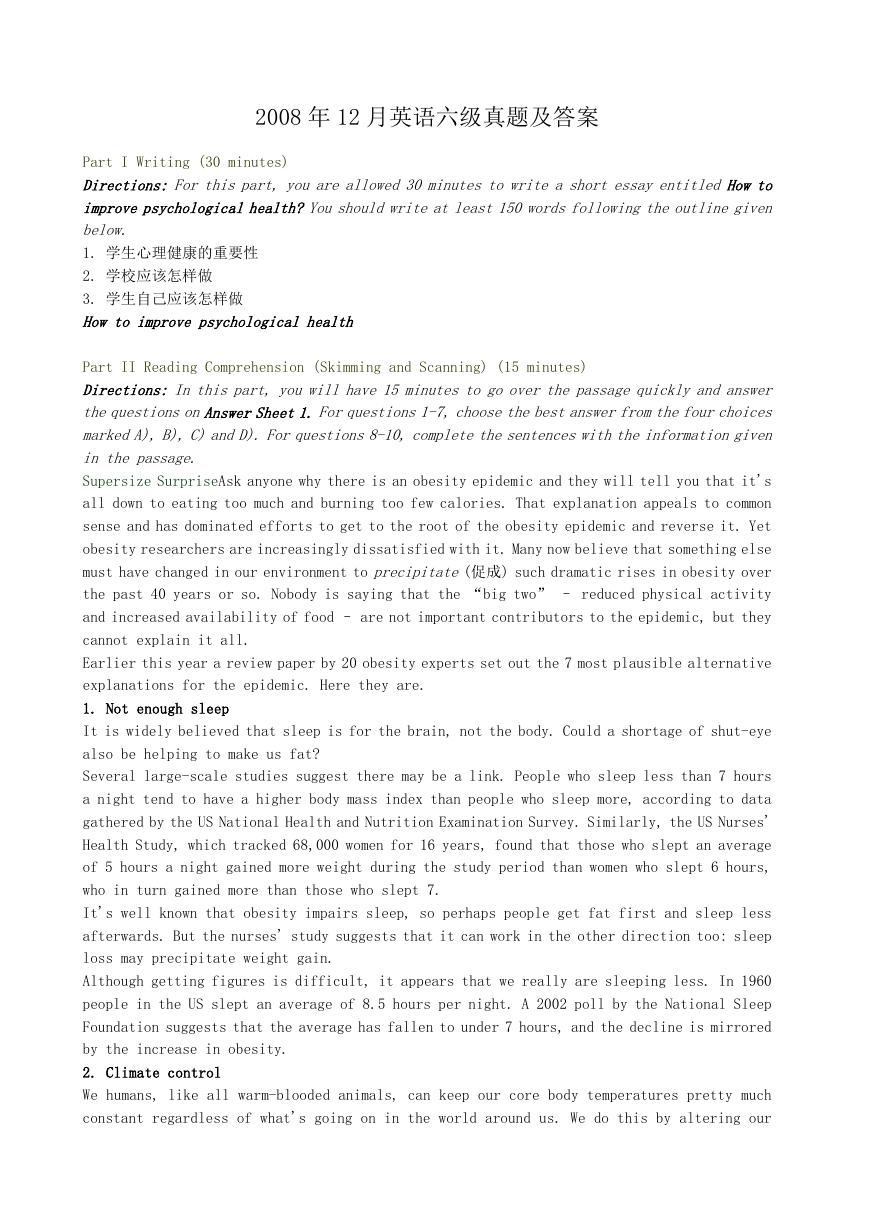
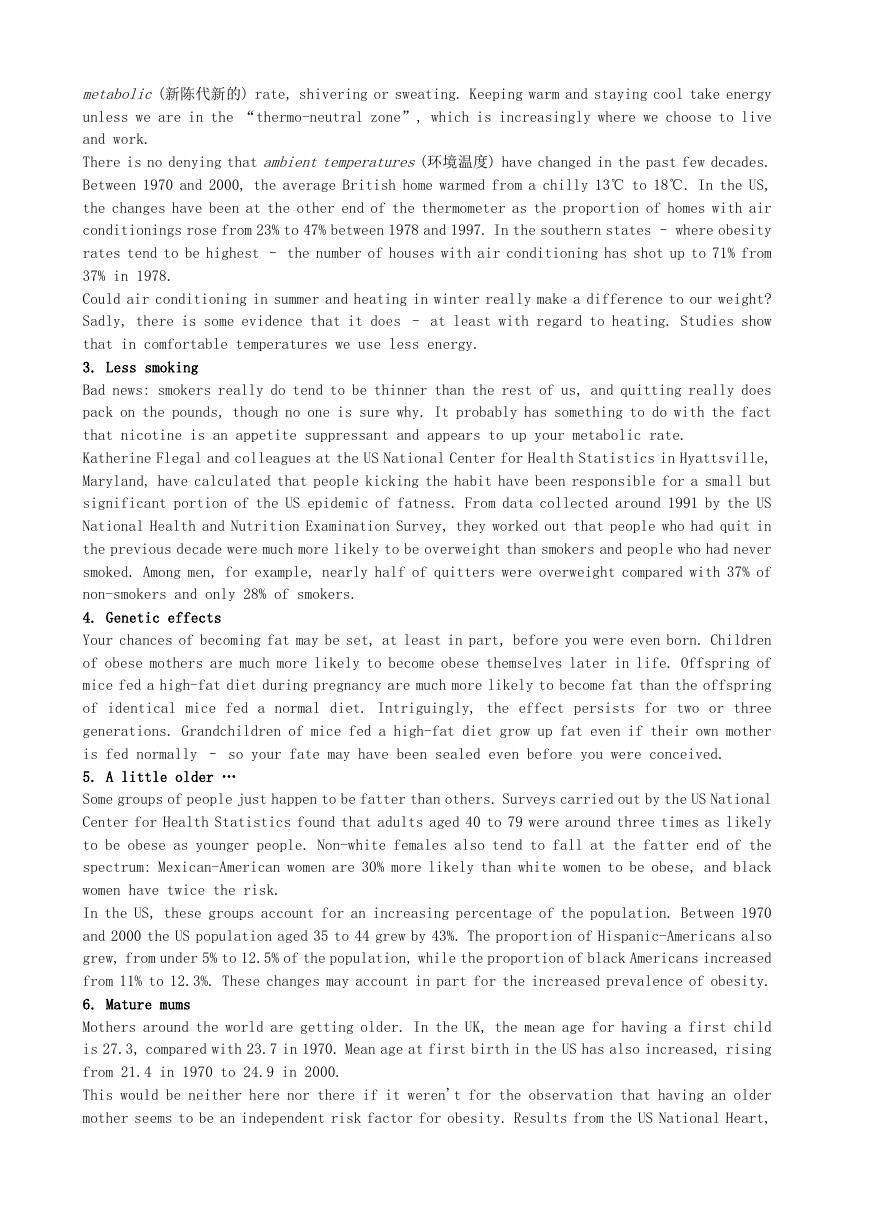
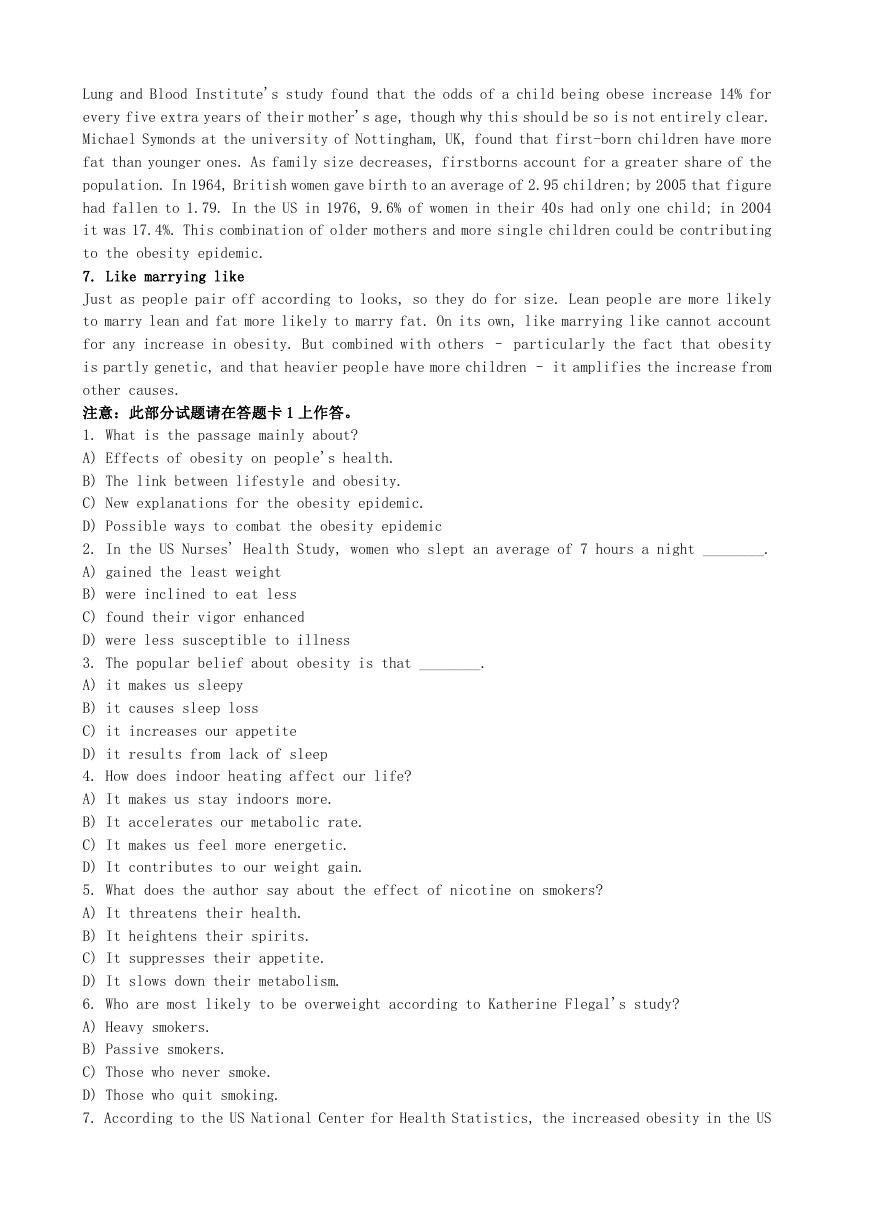
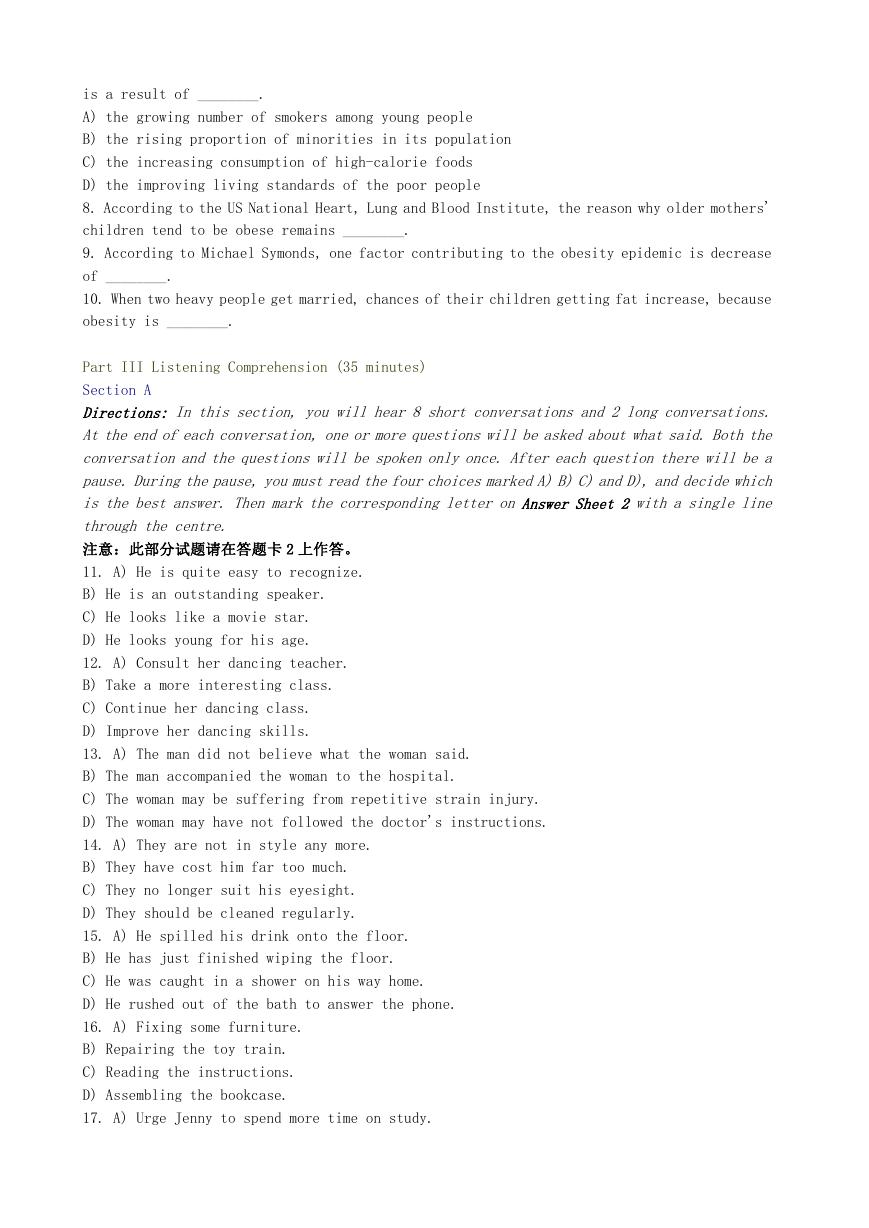
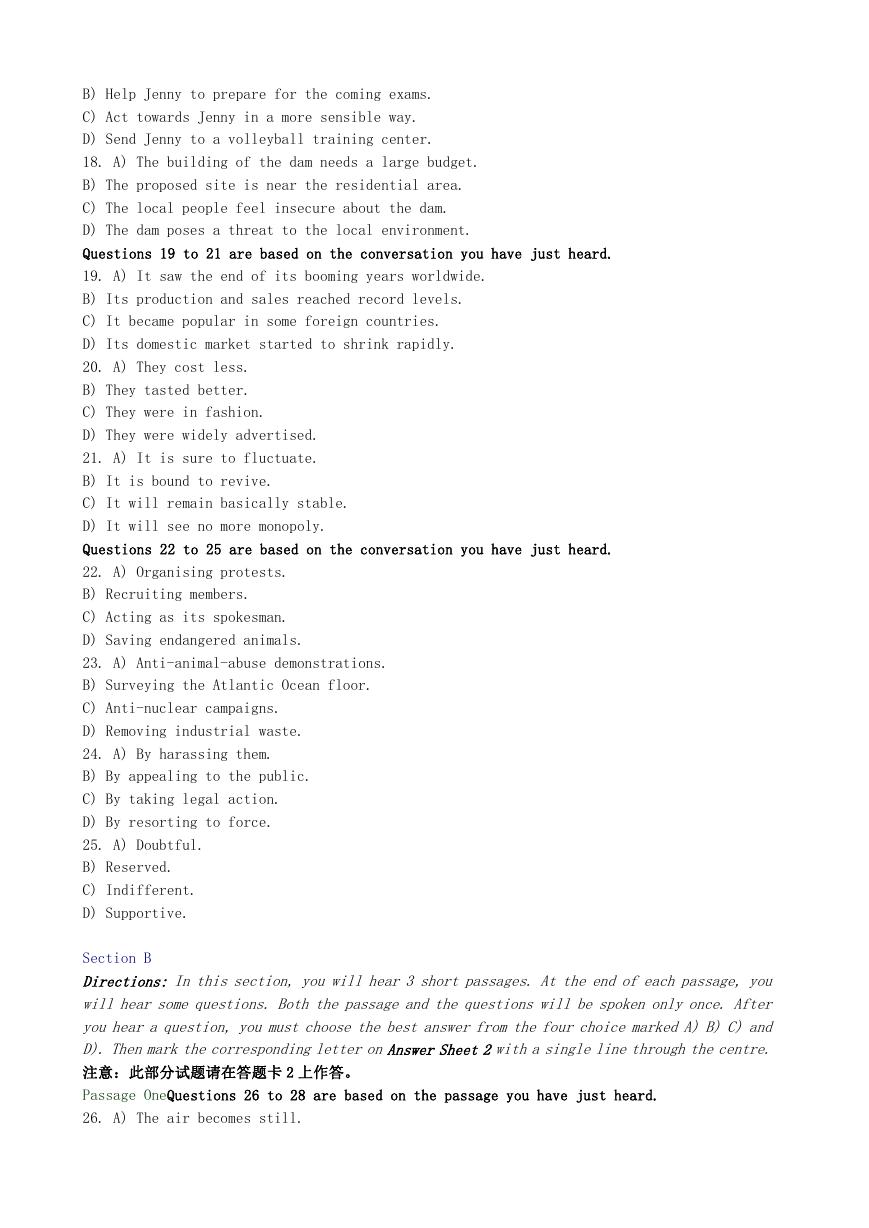
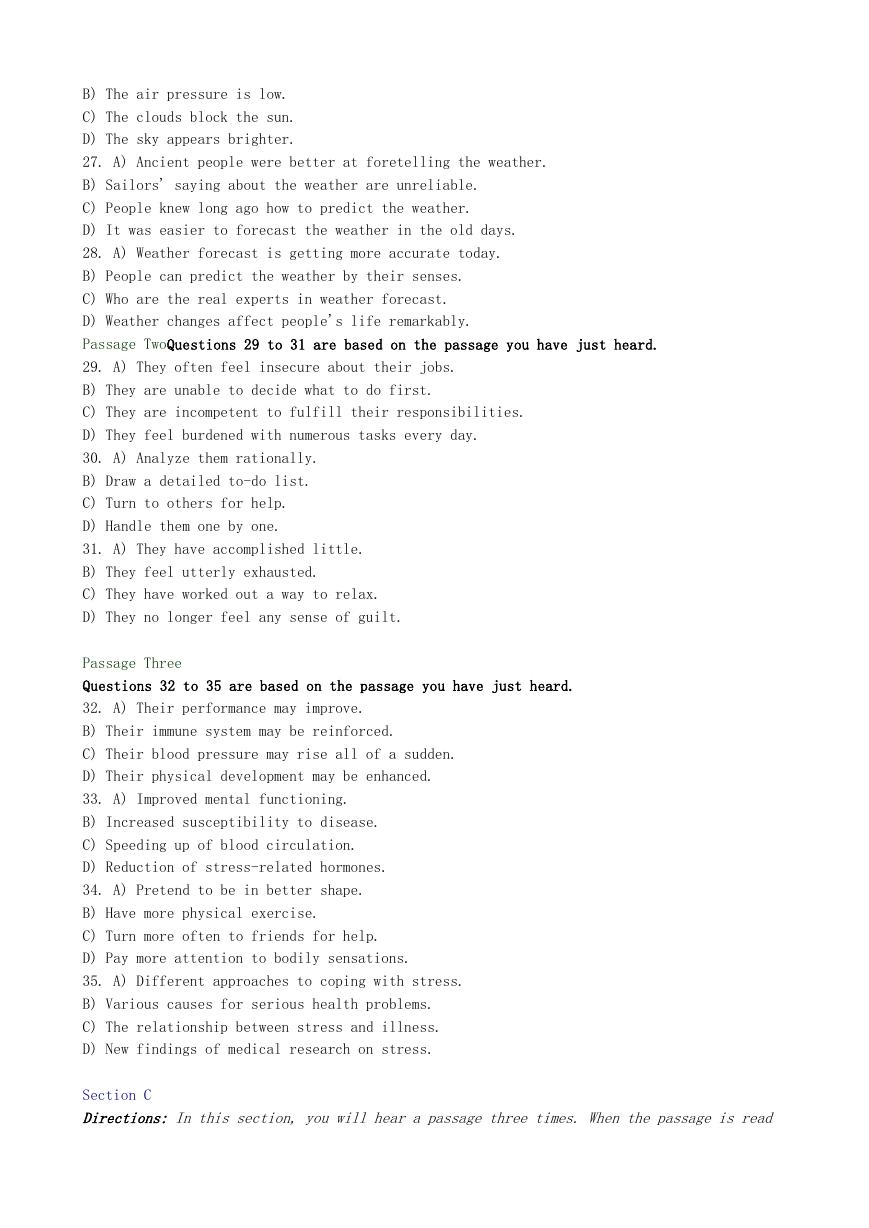
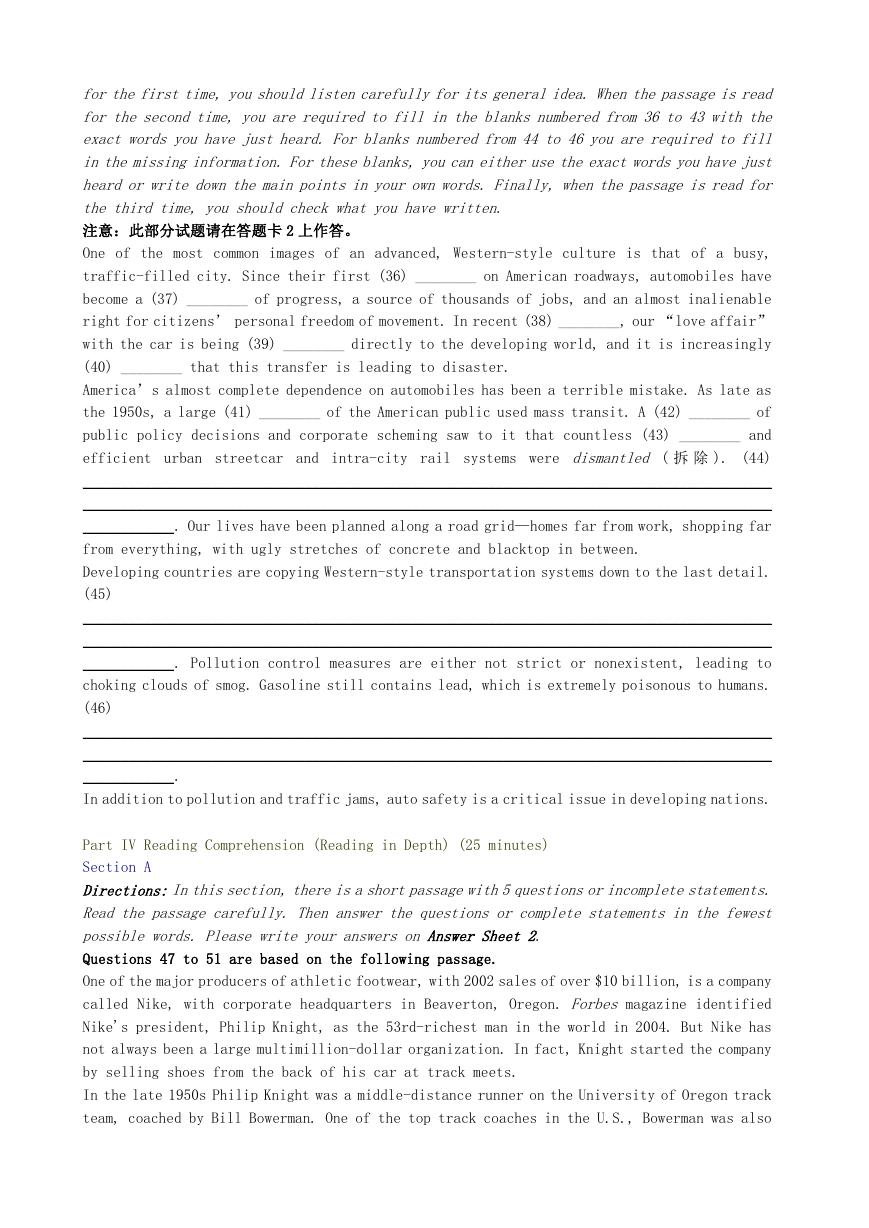
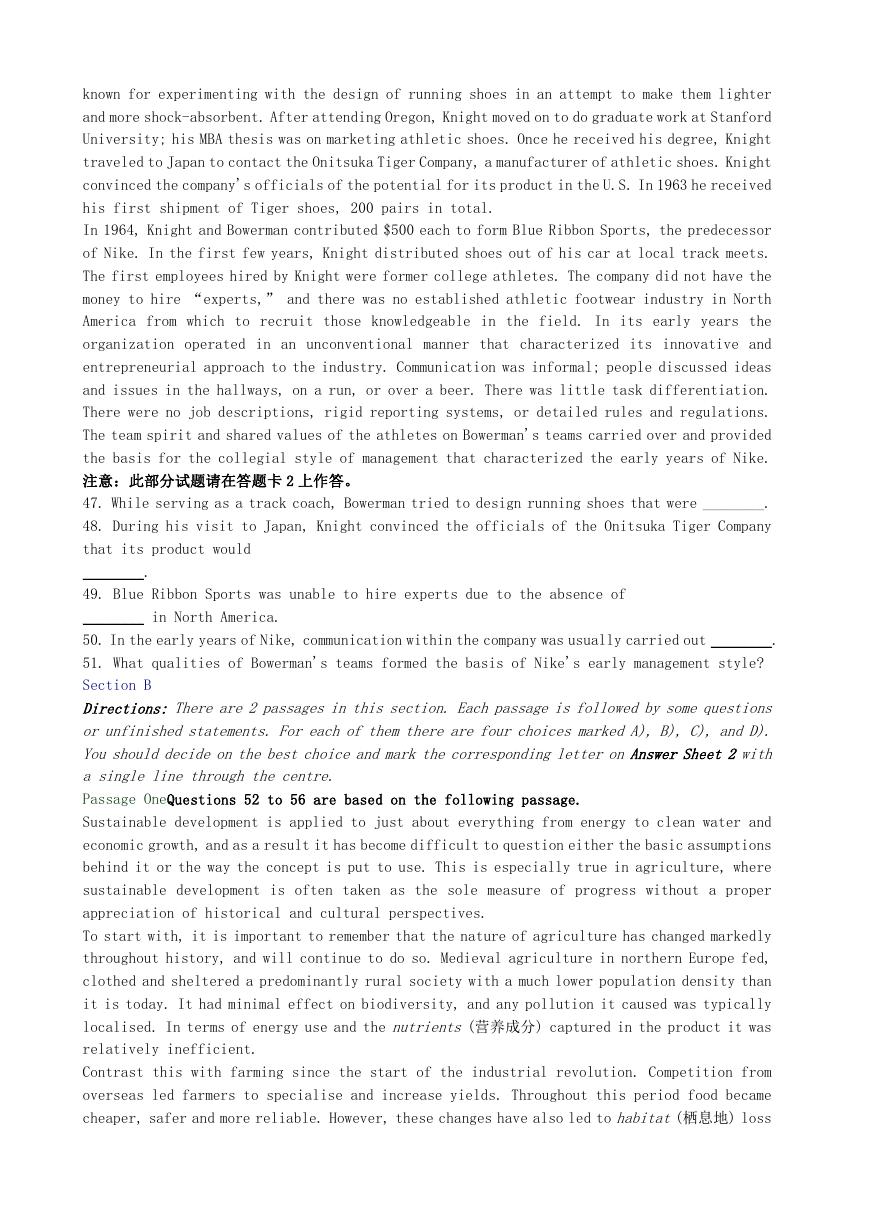








 2023年江西萍乡中考道德与法治真题及答案.doc
2023年江西萍乡中考道德与法治真题及答案.doc 2012年重庆南川中考生物真题及答案.doc
2012年重庆南川中考生物真题及答案.doc 2013年江西师范大学地理学综合及文艺理论基础考研真题.doc
2013年江西师范大学地理学综合及文艺理论基础考研真题.doc 2020年四川甘孜小升初语文真题及答案I卷.doc
2020年四川甘孜小升初语文真题及答案I卷.doc 2020年注册岩土工程师专业基础考试真题及答案.doc
2020年注册岩土工程师专业基础考试真题及答案.doc 2023-2024学年福建省厦门市九年级上学期数学月考试题及答案.doc
2023-2024学年福建省厦门市九年级上学期数学月考试题及答案.doc 2021-2022学年辽宁省沈阳市大东区九年级上学期语文期末试题及答案.doc
2021-2022学年辽宁省沈阳市大东区九年级上学期语文期末试题及答案.doc 2022-2023学年北京东城区初三第一学期物理期末试卷及答案.doc
2022-2023学年北京东城区初三第一学期物理期末试卷及答案.doc 2018上半年江西教师资格初中地理学科知识与教学能力真题及答案.doc
2018上半年江西教师资格初中地理学科知识与教学能力真题及答案.doc 2012年河北国家公务员申论考试真题及答案-省级.doc
2012年河北国家公务员申论考试真题及答案-省级.doc 2020-2021学年江苏省扬州市江都区邵樊片九年级上学期数学第一次质量检测试题及答案.doc
2020-2021学年江苏省扬州市江都区邵樊片九年级上学期数学第一次质量检测试题及答案.doc 2022下半年黑龙江教师资格证中学综合素质真题及答案.doc
2022下半年黑龙江教师资格证中学综合素质真题及答案.doc